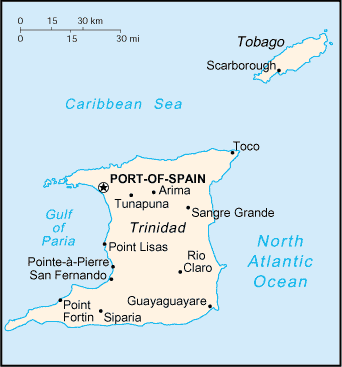My Island Paradise, part 5: coconuts and crix
Yesterday my dad and I went on an unplanned jaunt off to the other end of the island. For those of you who are following along and making notes (well, you might be...), here's a map:


Our vehicle for today's excursion was my dad's truly obscene BMW SUV, of which he is very proud, and insisted I take a picture.

Mayaro used to be a big coconut-growing region. So you drive along a lot of road which look like this.

And you eventually get to a coast which looks like this, pretty repetitively. If you've been watching any tsunami news coverage, you'll recognize the general shape of what you're seeing.

There are lots of little paths from the road to the beach that look like this.

Which lead to a coastline which looks extensively like this. The Mayaro coast faces the Atlantic, so the water is rough, dirty, and not terribly nice to swim in. The north coast is much nicer.

You get a lot of interesting flotsam and jetsam though, most of it from the Amazon and Orinoco rivers, which empty into the Atlantic below Trinidad and get swept along by currents.

Coconut trees are not, surprisingly, native to Trinidad, or indeed anywhere else in the Caribbean. They come from the pacific. The story of how so many millions of coconut trees ended up in Mayaro is therefore interesting, and indeed I'd never heard it before yesterday. So if any Trinis out there could either refute it or back it up, I'd be grateful. But apparently there was, a couple hundred year ago, a shipload of coconuts on the way from the South Pacific to start up a plantation in Brazil. The ship sank in a storm. However, coconuts float -- that's how they propagate from island to island. So the whole shipment of coconuts floated away from the wreck and floated to shore in Trinidad in their thousands, planting themselves on the east coast. From there, farmers decided to make use of this unexpected windfall, and planted them backwards from the coast for hundreds of metres, as well as carrying them to all other parts of the island.
It's a pretty crazy, random way to transplant an entire species to the Caribbean, but it's pretty interesting and has a certain ring of truth. You certainly don't get coconuts further inland anywhere in Trinidad -- it's all rain forest -- and you certainly don't get them on the north coast, except where they have been fairly obviously planted by people. But it's weird to think the coconuts trees I grew up with everywhere are an alien species.

A little bit further along the coast one of the rivers empties into the sea, forming a little lagoon.

The vegetation in the lagoon is proper swamp vegetation, with mangrove trees with the funky buttress roots to keep themselves upright in the mud. Bet you thought these were only in story-books, right?

We then took a little bit of a trek back inland. See how quickly it gets back to being rain-forest like rather than Pacific-island-ish?

This is what happens when there are no laws governing marketing gambits. This entire little corner store has been decked out in the colours of a single product. It's very striking and not really unattractive. Crix is a type of dry cracker. It tastes great with cheese -- or so any Trini will tell you. In reality, they're horrible, but like all Trini bread products they are packed full of preservatives, so they stay fresh for months, which is important when you're poor in Trinidad. The lifetime of unrefrigerated European-style bread in a tropical climate would be about two days, as opposed to the ten days that the leading Trinidadian brand manages.

This is an accidental shot I got of the Maxi Taxi in its natural habitat. Trinidad's dominant -- indeed, in much of the country its only -- form of mass transport, there are huge fleets of these identical little vans. They seat about 15, crammed in with varying degrees of discomfort and in sweltering heat. However, the journey from one end of the island to the other will cost you less than 30p, so you get what you pay for.
Maxis are all painted white with a coloured band across the middle. The colour of the band indicates the route the taxi is licensed to work, in this case black meaning the Sangre Grande/Mayaro route -- there are also red, yellow, light blue, green and brown. Before you marvel at how clever this is, it should be pointed out that to an outsider there is no indication that this is how the system works. There are no maxi stops -- they stop when you yell out you want to get off, or when you are standing at the side of the road waving to get on -- and no maps telling you what routes they cover, or what colour each route is. It's all a bit chaotic but then, that's what makes the system quintissentially Trinidadian.
